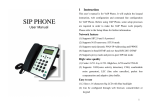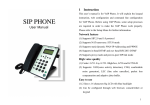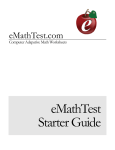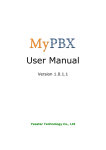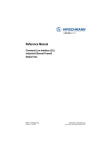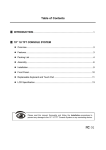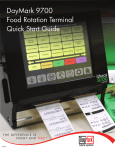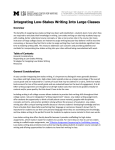Download The Learning Cycle user guide
Transcript
A Framework for Teaching and Learning The Learning Cycle user guide The Learning Cycle Reflect Demonstrate Activity Connect Share Learning Outcomes Share Information How does the Learning Cycle work? The diagram above outlines how effective teachers should design learning as a consistent approach to Teaching and Learning and is based on the accelerated learning model. The six part Learning Cycle supports teachers to structure their lessons to encourage consistency for students, but also facilitates flexibility of structure so progress is maximized for students. The six-part Learning Cycle consists of: Connect, Share Learning Outcomes, Share Information, Activity, Demonstrate, Reflect. A lesson should comprise of all parts of the cycle to facilitate good learning and progress starting with connect. When delivering the lesson, parts of the cycle can form loops for example demonstrate and reflect: students may need to return to demonstrate following reflection to improve upon their first attempt, it may also be appropriate to repeat the cycle within a lesson. When planning lessons, experienced teachers should consider the most effective number of cycles that are most appropriate to enable students to make good progress. Staff on training and support programmes will be guided to design lessons that follow one cycle by mentors and coaches. It is important to be flexible, but that the choices we make when designing learning come from a set of well-tested principles. This allows us to be consistent and coherent in how we operate. Using the six-part Learning Cycle What should be included? All lessons will contain at least one Learning Cycle starting at connect. To guide staff and to ensure consistency of Teaching and Learning, this has been defined into Must, Should and Could statements. The basic components of lessons are Must statements indicated in red; Should and Could statements bring in flexibility to meet the class needs rather than following a prescriptive formula. *Must statements form The Cockburn 10 and are the basic components of the Learning Cycle and essentials for every lesson to ensure quality and consistency of Teaching and Learning. See final page of this user guide. Explanation of Connect Phase. Connect phase helps students to settle, focus and begin learning. Connect can take different forms, enabling the teacher to gauge what the students have retained from previous lessons. This is the first barometer reading of the class indicating progress. There is not one prescriptive way of delivering Connect, the teacher should select the most effective strategy to start the lesson. Connect Phase: what the teacher is doing, what the students are doing. Whatever approach the teacher selects for Connect, it must engage students in learning. Connect sets the tone of the lesson and establishes high expectations for learning. Teachers are reminded that in the outstanding classroom Connect is varied, exciting and relevant over a series of lessons. Explanation of Share Learning Outcomes Phase. Sharing Learning Outcomes phase makes the learning purposeful, relevant and sets learning in context. Expectations around learning and progress are made clear in this phase, but again there is no prescriptive way of delivering this phase. The teacher should be mindful of too much teacher talk and overly complicated learning objectives that may slow the learning process. Share Learning Outcomes Phase: what the teacher is doing, what the students are doing. Teachers are reminded that in the outstanding classroom, how students will make progress is made clear through the success criteria, learning objectives must be displayed throughout the lesson and build in challenge and demand over a series of lessons or scheme of learning. In some instances teachers might want to pose a big question or problems first without clarifying the learning objective to encourage thinking and metacognition. Example phrases teachers might usefor Sharing Learning Outcomes: “If you are really successful today you will be able to do, say, show, this will be good progress.” “To make good progress we need to...” “If you can...we have made good progress” “What we are learning today is hard, but we will know we have made good progress by...” “To achieve your target grade/level you will need to...” Explanation of Share Information Phase. Sharing Information phase is providing the key information students need to solve a problem or undertake learning. This is an opportunity to be creative, pose questions and engage curiosity. Teachers are encouraged to be mindful of too much teacher-talk during this phase. Share Information Phase: what the teacher is doing, what the students are doing. Teachers are reminded that in the outstanding classroom this phase invites the selection the most effective methods to share information, this invites creativity, innovation and risk-taking to try out exciting methods of sharing information. Teachers should use a range of questioning strategies and consider what methods students will use to give their answers or take part in the sharing of information. Explanation of Activity Phase. Activity phase is when students are completing a task or an activity. Students are engaged, busy, challenged, stretched and concentrating. This is another barometer point for progress in the lesson and invites teachers to reshape the task where necessary. Activity Phase: what the teacher is doing, what the students are doing. In the outstanding classroom, teachers must take the opportunity to re-shape tasks where necessary, it may be appropriate to make a loop back to share information if the task is not working or to reflect on the progress made so far. Differentiation should be a planned part of the activity phase focusing on matching the needs of groups or individuals. Differentiation by outcome is only acceptable when students are undertaking a test. Explanation of Demonstrate Phase. Demonstrate phase frequently forms a loop with Activity and Reflect. In this phase students are given opportunities to generate the products that demonstrate their understanding and progress. Demonstrate Phase: what the teacher is doing, what the students are doing. Teachers are reminded that in the outstanding classroom all students have the opportunity to apply learning to new contexts. This is another barometer point for progress in the lesson and invites teachers to reshape the task, loop back to Activity or move to Reflect. Explanation of Reflect Phase. Reflect phase is crucial to effective learning and progress. This is where students understand the progress they have made and this enables the teacher to plan effectively for future learning. This is the final barometer reading of progress before they leave the room, but Reflect can be used at any point in the cycle where the teacher feels it is necessary to reflect on progress achieved at a particular point. Reflect Phase: what the teacher is doing, what the students are doing. Teachers are reminded that in the outstanding classroom all students have the opportunity to reflect on learning and progress made during the lesson and to plan ahead for the next lesson. This helps students to prepare for future learning and enables lessons to connect together sequentially rather than be disjointed. The Learning Cycle structure in summary: Cycle Connect Sharing Learning Outcomes Share Information Activity Demonstrate Reflect Teaching Strategy Must effectively engage students in learning. Could use relevant starter activities. Could* review previous learning. Could* respond to marking, feedback or homework. Could start with independent learning. Could start with an open ended task. Could start with a big question to solve. Could* contain peer or self assessment tasks. Must* be shared during the lesson consisting of a learning objective and success criteria to make progress explicit to students. Must be displayed throughout the lesson. Must* record the learning objective at the beginning of the piece of work. This may not be at the beginning of the lesson. Should* be shared/ revisited at any point during the lesson where appropriate. Should link to bigger picture and promote SMSC/school values & expectations. Could* be shared by asking what students already know. Could be established by students. Could be shared as the lesson and learning progresses. Must consider most effective methods to share information to maximize inclusion and impact. Should* use a range of questioning strategies to address misconceptions. Should be aware of too much teacher talk or over teaching during this phase of the lesson could hinder progress. Should* promote active listening strategies. Could be student-led. Must* listen, observe and judge when it is appropriate to review learning with class or individuals to maintain appropriate pace of learning or reshape the task. Must match students needs accurately. Should promote one or more of students’ high levels of resilience, confidence and independence. Should contain tasks or activities that provide challenge through appropriate differentiation. Should show high interest in achieving the objectives of the lesson. Should promote RWCM inc SMSC where appropriate. Could organise students to work independently, in pairs or groups. Must ensure students apply learning to new contexts or different situations or deepen and develop existing knowledge and skills. Should use a range of skilful questioning strategies, often reshaping tasks. Should promote RWCM inc SMSC where appropriate. Could* contain peer or self assessment tasks. Could contain the setting of homework tasks. Must* be based on accurate assessment of prior learning. Must* contain skilful questioning that is purposeful/meaningful, often reshaping tasks. Must* contain systematic and effective checks of students understanding throughout lessons, anticipating where to intervene and doing so with notable impact on the quality of learning. Must contain a review or summary of learning. Should* contain self reflection (using success criteria, could be levelled, could be whole class, could be groups/1to1) Should* contain retention of prior learning. Could* contain peer or self assessment tasks. Could* prepare the learning for the next lesson. Could* be student-led. Could contain the setting of homework tasks. Must statements form The Cockburn 10 and are the basic components of the Learning Cycle and essentials for every lesson to ensure quality and consistency of Teaching and Learning. The Cockburn 10 Essentials for every lesson. High expectations for learning & behaviour. Connect the learning to engage. Share learning outcomes & success criteria. Consider most effective methods to share information. Check & reflect on the learning. The Cockburn 10 Listen, observe, reshape the task. Skillful questioning. Accurate prior assessment inc marking. Ensure students apply learning. Match student needs accurately via differentiation & challenge.











